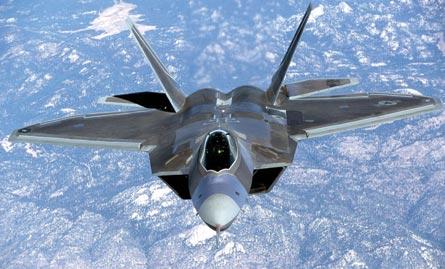This year, the US Air Force started fielding the Increment 3.1 upgrade to its Lockheed Martin F-22 Raptor fleet.
The modifications add a synthetic aperture radar (SAR) capability to the fighter's Northrop Grumman APG-77 radar, plus electronic attack, better geo-location capabilities to find enemy radars and the ability to carry eight 113kg (250lb) small diameter bombs (SDBs), for use in pairs against four ground targets.
Introduction of an SAR mode will assist during the manual targeting process, which is an improvement over the previous Increment 2 configuration's use of two 454kg Joint Direct Attack Munition satellite-corrected, inertially guided bombs against individual targets.
 |
|---|
© Lockheed Martin |
The USAF has not been forthcoming about the precise details of the Raptor's new electronic attack mode.
Starting in 2014, the USAF will also field a series of Increment 3.2 upgrades split across three packages. Aircraft would start to enter the second of these in 2017, and while the third package has yet to be fully defined, the service wants to add open-architecture hardware and software during this phase.
Key elements of the Increment 3.2 enhancements include the addition of Raytheon's high off-boresight AIM-9X and AIM-120D Amraam missiles, and the ability to retarget independently up to eight SDBs against eight separate targets. Automatic ground collision avoidance and anti-jamming systems will also be incorporated.
However, the F-22 will not receive a helmet-mounted cueing system or the new multifunction advanced data-link (MADL).
MISSING PARTS
USAF sources say the lack of a helmet-mounted display will only preclude pilots from exploiting the outer edges of the AIM-9X's envelope, but that the new weapon will still greatly increase the Raptor's potency.
The lack of a new data-link, however, is a problem, as the MADL would have allowed the Raptor to trade data with the Lockheed F-35 Lightning II and Northrop Grumman B-2 bomber. While the F-22 does have the ability to communicate over secure voice with other aircraft, it can only share data with other Raptors via its intra-flight data-link and a handful of specially equipped Northrop RQ-4 Global Hawk unmanned air vehicles.
When the USAF was first learning to coordinate F-22s with "fourth-generation" jets, the Raptor's inability to transmit over the Link 16 data-link was a vexing problem. But pilots learned to "de-conflict" through timing and more detailed briefings.
The USAF hopes to eventually develop a new data link that would solve the problem, Lt Gen Herbert Carlisle, the service's deputy chief of operations, plans and requirements said in February.
There are also some planned combat identification algorithms that will be added to the APG-77 radar. Additionally, the F-22 programme has begun to retrofit improved stealth materials from the F-35. The new materials improve the durability of the aircraft's coating, but do not impact the Raptor's radar cross-section.
Source: Flight International



















